
Lewis Eady's, 192 Queen Street: Marlene Short leaves work in the late 1960s. - Marlene Short collection
Marlene Short was 16 years old when she started at Lewis Eady’s in the mid-1960s:
“I joined when I left school, I was the tender age of 16 and stayed until I was 23. I wanted to get a job in a music shop and I would go through the paper looking for jobs, make some appointments for office jobs and when I got off the ferry, would ring up and cancel the appointments and walk around the city and look at the music shops.
“One day there was an office job at Lewis Eady’s advertised so I went for the interview, and they didn’t hire me for the office job, but put me in the box office right next to the record dept. My mother never did find out!
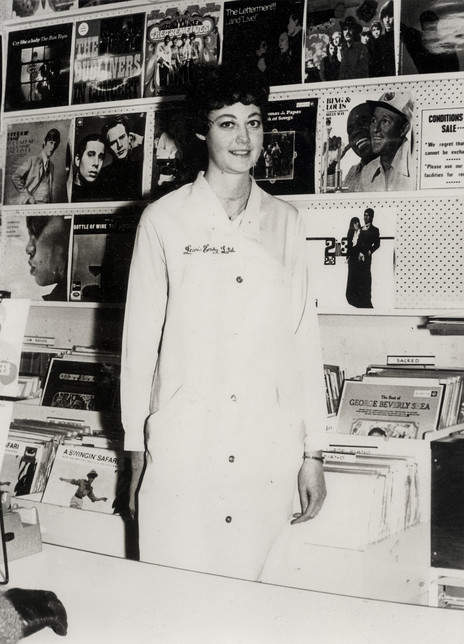
Marlene Short at Lewis Eady in the store uniform, ca. 1968. - Marlene Short collection
“I had a great training from a woman there. She smoked all over the place, had a very loud voice and was very theatrical. She needed help in the record department. And at that time, I was working in the box office near the front selling theatre and show tickets. I put my hand up and volunteered to go and work there – I was 17. I noticed that she was giving lots of records away and marking up deletions that she’d buy from companies by quite a lot. I was so naïve and asked the company secretary one day, ‘are we supposed to be marking all these records up?’ ‘No!’ he said. They investigated and discovered that she’d been trading records all over town for hats and shoes and goodness knows what. So, she was let go immediately and at age 17 I was put in charge of the record department. Seventeen!”

Lewis Eady staff: Glenys Lambert, Jill Watt and Marlene Short. - Marlene Short collection
This was 1966 and the record department – by now all on the ground floor, between the box office and the hi-fi department at the rear – was still probably the biggest musical retailer in Auckland, perhaps in the whole country. Marlene recalls selling 500 copies of the Bee Gees hit ‘Spicks and Specks’ shortly after its release, and the shop hummed for late-night shopping on Fridays. Only Marbecks came close as a record retailer in the CBD.

The record department at Lewis Eady in Queen Street, c. 1970 with Marlene Short, unknown and Betty Ackerman to her right. Lorayne Jardin is in the distance (with the long hair). - Photo by Kevin Hall, Auckland Libraries Heritage Collections 1160-1-17A
“Queen Street was a very busy street on Friday nights, and Marbecks was in an arcade. Murray and Hayden also weren’t quite as gregarious as I was. We had the same customers coming in every Friday night. You knew their tastes and they’d ask what was new that week. You knew just what your regular customers wanted, and they’d buy records every single week.”
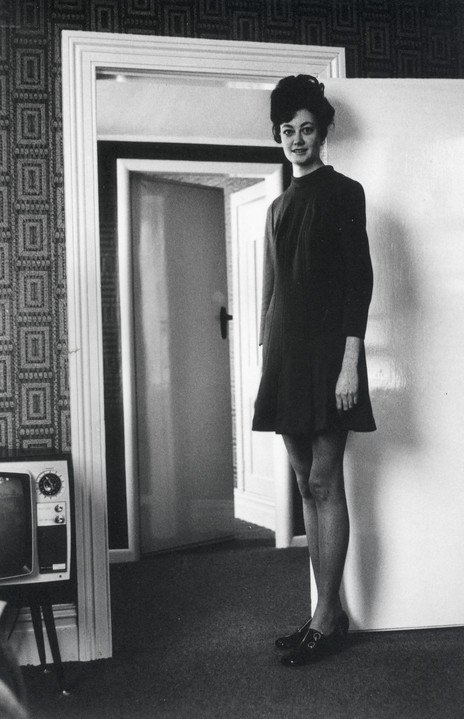
Marlene Short: John Coltrane sent shoppers home on Friday nights. - Marlene Short collection
“Friday night was party night. When we wanted to shut the shop and go home, we would put on John Coltrane’s A Love Supreme at nine o’clock. But when we wanted to party and stay there, which was more often, we used to play Trini Lopez.”
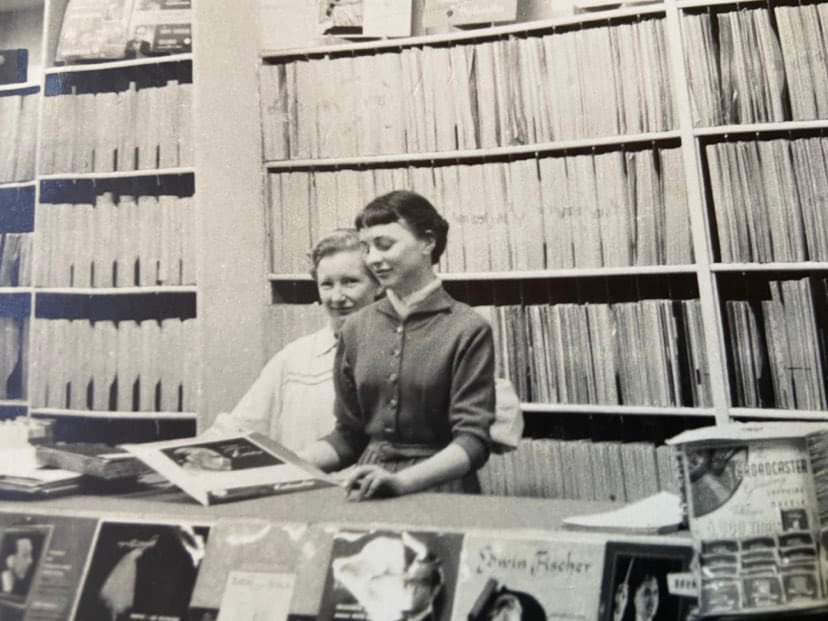
Elizabeth Crowhurst in the record department of Lewis Eady in Queen Street in the mid-1950s. Aged around 16 when this was taken, she recalled to her family the time when the store received its first shipment of Bill Haley & The Comet's 'Rock Around the Clock'. The store played it over the speakers out into Queen Street and instantly sold the lot. - Gaylene Kennedy collection.
Brent Parlane, later of Beech and a country star in Australia, recalls his first visit on a Friday night, in 1965:
“I was living with my family on the Whenuapai air force base just west of Auckland. I would have been 12 and some of the other kids asked if I wanted to go into town with them. This meant getting permission from my mum and a little spending money too. To my surprise she said yes, and I was off on my way.
“At Lewis Eady’s you could sift through the singles on the ground floor and ask one of the assistants to play the record for you. You would be directed to one of about five listening booths where you would stand in a small three-sided space with acoustic tiles and two speakers and listen for free. I remember listening over and over to the new Beatles single ‘I Feel Fine’, the first 17 seconds of which remain one of my favourite moments in all creation.
“Upstairs were the LPs, way out of my price range or course, but you could look at the covers all day. My friend Chris had played me his big brother’s copy of ‘Blowin’ In The Wind’, not the Peter Paul and Mary cover version, but the original by the guy who wrote the song. And there he was, walking down the middle of the street with a beautiful girl on his arm, through the New York City snow. If there was a cooler guy on the planet at that moment, nobody had told Bob Dylan!”
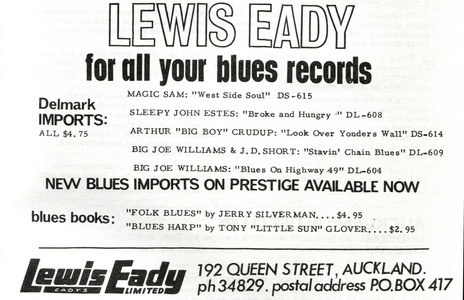
Lewis Eadys blues ad in Blues News, 1970.
My own memory of the Lewis Eady record store was a shop that literally sold everything. If it was released in New Zealand, it was there. Unlike most other stores, if it was released in other countries and mattered – but was unreleased in New Zealand – it was still likely there as an import. Most retailers were limited by what was released locally by a handful of local wholesalers (in the 1960s essentially His Master’s Voice, Pye and Philips, with Festival arriving later).
The record covers were tightly crammed into the wooden bins, in zipped plastic sleeves and some had been there for so long there was a slight musty odour. Newer records would sit next to hard-to-find deleted records that the store had bought in quantity on release. The racks on the wall and behind the counter would have Leonard Bernstein sitting next to Frank Zappa and Miles Davis.
By the end of the 1960s, newer, boutique record stores were arriving, stores that catered for the generation now reading Rolling Stone magazine. Despite that hipness threat, Eady’s had a standing, almost an implied grandeur, that drew from the fact it had been doing what it was doing exceptionally longer than anyone could remember. It was an Auckland institution. While Direction Records may have had customers for The Doors and Tim Buckley, nobody went there for Bach, Ellington, Herb Alpert or The Seekers. Lewis Eady sold the lot and had people on hand who could talk with knowledgeable assurance both Dylan and Matt Munro if need be.
As a kid, my bus stopped nearby, and the record department was a big reason why that multi-storied emporium was so enticing to a 13-year-old with pocket money to spend and a school holiday destination.
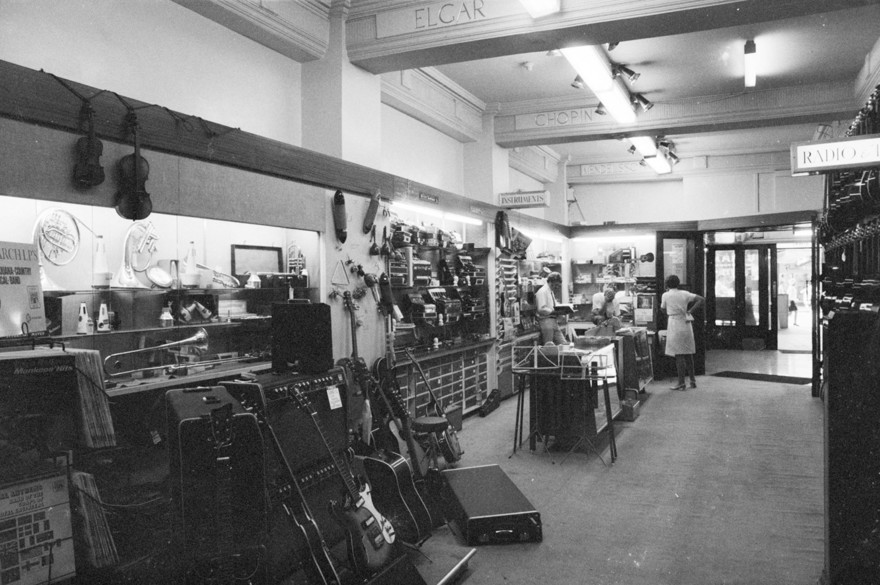
Musical instrument department at the front of the ground floor in Lewis Eady, looking towards Queen Street. The woman facing out is Marlene Short’s mother, c. 1970 - Photo by Kevin Hall, Auckland Libraries Heritage Collections 1160-1-07A
Harry Lyon, later of Hello Sailor and a working musician for some 50 years was one of those who never lost the thrill he encountered as a teen:
“I’d been given a three-quarter scale Stratocaster-shaped Watkins Rapier electric guitar for my 12th birthday and my father made me a 15-Watt amplifier based on a circuit from a Popular Mechanics magazine. It was enough for me and the band I had with Dave McArtney in 1963/4 that played mostly Shadows covers. I had the music bug bad and had seen the Beatles, Stones, Yardbirds, other Brit bands and US acts like Roy Orbison, Del Shannon that came through Auckland at that time: I hungered for a Gretsch (like George) or an Epiphone (like Keef).
“In the early to mid-60s I used to do the rounds of music shops in the city on Friday nights. Sometimes with mates but often as not on my own. There was Alan Kingsley-Smith’s little shop in Rutland Street, Atwaters nearby on Queen Street up from the Civic Theatre, Sydney Eady down further on the corner of Swanson Street and Lewis Eady at 192 Queen Street, just up from Durham Street East.
“I was a regular at Lewis Eady on Friday nights, they were on the ground and the first floor. I can’t remember too much about the street level, I think they sold pianos, records, and sheet music. I made straight for the first floor where the guitars, drums, amps, and other ‘band’ gear was. Frank Gibson Sr was usually there, and I would be pretty much tyre-kicking electric guitars out of my price range. Frank would fetch a guitar down for me and hang about nearby as I played my Shads licks and then various bits and pieces from current hit parade songs.
“There was a stage with backline set up and people would get up and jam. They were mostly a bit older than me, and I lacked the confidence to join in. I remember Frank saying, ‘Are you in a band? Why don’t you get up with the others and have a play? You’re good enough.’ Just generally really encouraging. I never did have the bottle to jump up, but it certainly helped when I finally answered an ad: ‘Wanted, singer/guitar player, 17-20, for working North Shore band. Good gear and transport essential.’ That was 1966 for The Legends and I got the gig despite being 15, with a Maton Supreme, my 15-Watt amp and a Hobby motor scooter for wheels. Thanks Frank!”
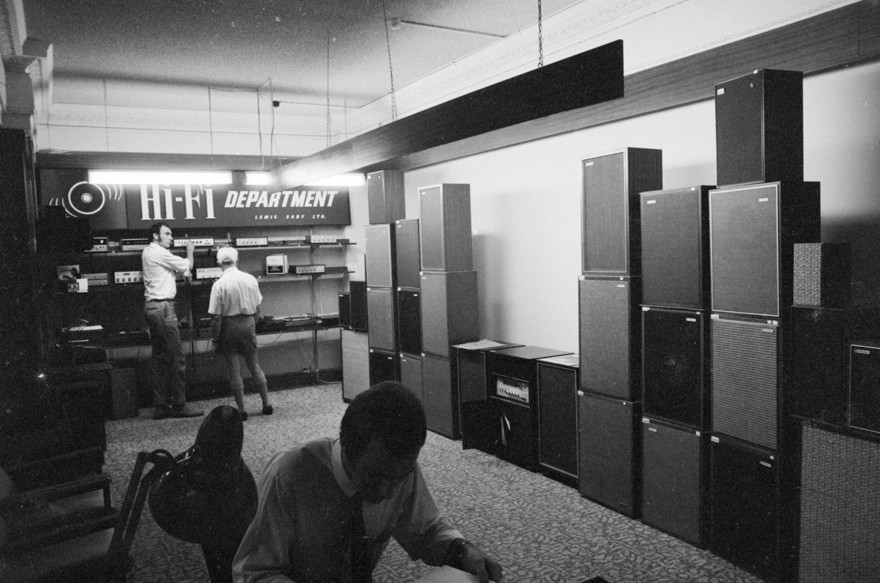
Stacked loudspeakers in the Hi-Fi department at Lewis Eady in Queen Street, c. 1970. - Photo by Kevin Hall. Auckland Libraries Heritage Collections 1160-1-10A
Mike Chunn, later of Split Enz and Citizen Band, has similar memories:
“To a boarding-school kid who had stuffed his school clobber in a duffle bag in the downtown bus terminal toilets and put on ‘civvies’, the walk up Queen Street which followed was a huge excitement. And it was straight on up to Lewis Eady’s where musical instruments and amplifiers, drums etc – along with a fulsome record counter – waited for intense observation. Far more than perusal. Oh, and dreams: because I never had money and never once bought anything from there. But as a priority Beatles’ fan, the imagination, the dream was rampant.
“To hold onto the Beatles’ magic for a moment – it was 1967 that my most favourite memory image still burns in my head. The record counter had a wall of Sgt. Pepper’s covers: dozens and dozens of them. It was a psychedelic overload and the moment when I thought, ‘there must be some way I can get to play on a record and have the cover go up on the Lewis Eady’s wall.’ That was a dream worth holding onto!
“But most of my time in Lewis Eady’s was looking at, touching, and picking up the two or three Jansen bass guitars they had for sale. I was too nervous to ask if I could plug them into an amplifier. I plucked away on them until the shop assistant asked me to stop. And then I was out onto the Queen Street footpath with my dreams safe in my imagination waiting for the next visit.
“And in case you’re wondering – I did eventually play on an album and the cover went up on the Lewis Eady’s record counter wall. Dreams come true!”

The repair workshop at Lewis Eady, facing out to High Street, 1970. - Photo by Kevin Hall, Auckland Libraries Heritage Collections 1160-1-18A
Brent Parlane, the kid who had wandered into the city with his mates looking for teenage thrills and music:
“My interest in music was well on its way, what with the Beatles becoming millionaires and being chased around by all those girls (that looked like a pretty good job to me!)
“Up against the front wall on the second floor was a row of electric guitars you were allowed to take down and play. This was incredibly exciting for a kid who was struggling with his first Suzuki beginner’s acoustic with finger-bleeding action high enough to be a Dobro! Their electrics were mainly Framus, and the dreaded Burns Bisons (the heaviest guitar I’ve ever held) or crappy Hofners. However, it was cool to have a play on them and dream a little.
“There were also a few bass guitars, and yes some were the violin Hofners that Paul [McCartney] played. If only I had the 30 quid they cost, the profit I could have made.
“After the guitars had been tried and LPs looked at and the glances of the weary shop assistants noted, it was back downstairs to nick a few picks and then back on the bus out to Whenuapai to follow that dream.”
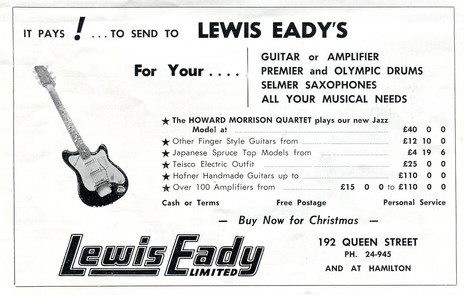
A NZ Herald guitar advertisement from 1961 featuring an endorsement by the Howard Morrison Quartet. - Papers Past
For Marlene Short behind the counter, it was more than just a job by the late 1960s, in part because much of her family had followed her to the store:
“My brother worked upstairs with a Mr Allen and used to do all repairs on radios and suchlike. And even my mum – she ran the lift.
“When I turned 21, Frank Gibson Jr and some of the other musicians came to my house in Devonport to play at my birthday party. I used to go to all the jazz clubs. I’d go and hear Frank play everywhere, all around town. He taught me a lot about jazz.”

An HMV function at the DB Hotel, Albert and Wellesley Streets, ca. 1970. On the left is Marlene Short, and in the leather jacket is David Perkins from Taste Records. - Marlene Short collection
The 1970s saw the arrival of a new type of record store. Direction Records and Taste Records both provided a more targeted service, selling less Top 40 and more alternative sounds. To a new generation Radio Hauraki, a rejigged 1ZM, and overseas media were the influencers. The future of recorded music retail had arrived.

An HMV function at the DB Hotel, Albert and Wellesley Streets, ca. 1970. Second from left Marlene Short with David Perkins from Taste Records next to her. - Marlene Short collection
Despite the generational shift, there was a still a camaraderie among the retail staff. After Taste Records opened in 1969, Marlene Short even appeared as a witness in court to support the battle of its owner Dave Perkins to open on Saturday mornings (without the permission of her employer, who probably would not have given it).
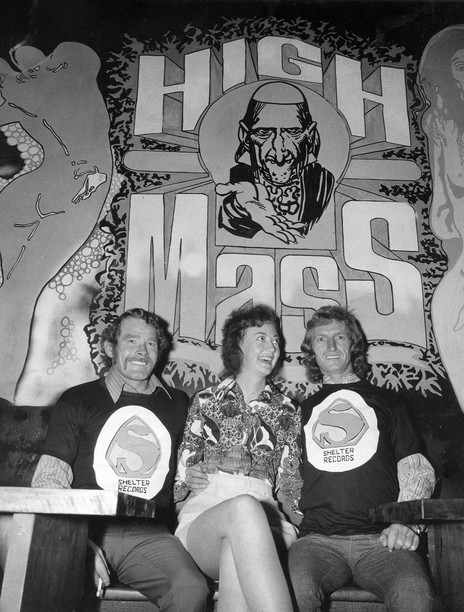
The launch of the Shelter label by Pye at Lewis Eady. In the centre, Marlene Short; Tommy Adderley on the right, 1971. - Marlene Short collection
“I loved that man. Wasn’t he wonderful? I went to court for them when they were trying to get a licence to trade on a Saturday morning. They were fighting the [retail workers] union who wanted the ban to stay – however, the union bloke used to buy all his records off me! There I was, in another awkward situation. I was going to court for Dave to get a licence to trade, and the union guy was my customer. He didn’t want them to open on a Saturday. Dave won the court case though. I lost a customer.”
Marlene left Lewis Eady in 1972, aged 23, moving to the record company RCA and then to Australia where she still lives, retired in Gosford. Her two eldest children are named Miles and Brook (from Davis and Benton respectively).
--
Read more on AudioCulture: Lewis Eady’s, Queen Street